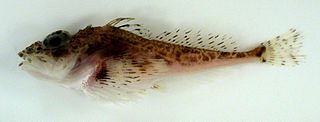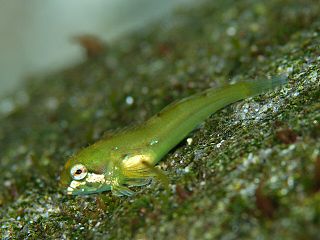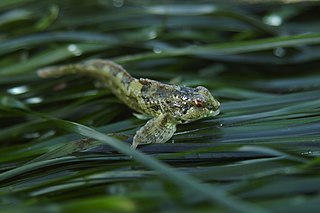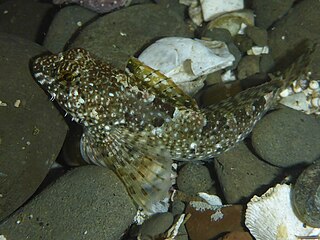
The scaled sculpins, Icelus, are a genus of marine ray-finned fishes belonging to the family Cottidae, the typical sculpins. Most of the fishes in this genus are found in the northern Pacific Ocean but they also occur in the North Atlantic Ocean.

The snubnose sculpin, Orthonopias triacis, is a species of marine ray-finned fish belonging to the family Cottidae, the typical sculpins. This fish is found in the eastern Pacific Ocean.

The Norway bullhead is a species of marine ray-finned fish belonging to the family Cottidae, the typical sculpins. This species is found in the northeastern Atlantic Ocean.

Clinocottus globiceps, the mosshead sculpin or globe-headed sculpin, is a species of marine ray-finned fish belonging to the family Cottidae, the typical sculpins. This sculpin is found in the northeastern Pacific.

Clinocottus is a genus of marine ray-finned fishes belonging to the family Cottidae, the typical sculpins. They are nearshore benthic fishes native to the northeastern Pacific Ocean. They are mentioned as sharpnose sculpins.

Clinocottus acuticeps, the sharpnose sculpin, is a species of marine ray-finned fish belonging to the family Cottidae, the typical sculpins. This sculpin is found in the eastern Pacific Ocean.
The Andriyashev largeheaded sculpin is a species of marine ray-finned fish belonging to the family Cottidae, the typical sculpins. This species is found in the northwestern Pacific Ocean. This monospecific genus, and therefore this species, are known from a single specimen, the holotype. This was collected from off Simushir Island in the Kuril Islands at a depth of 100 metres (330 ft). That specimen had a total length of 23.6 cm (9.3 in) long. FishBase classifies this taxon within the Cottidae but other authorities classify it within the subfamily Psychrolutinae of the family Psychrolutidae. The genus name Andriashevicottus includes a patronym, the person honoured was not identified by the describer Fedorov, however, it is almost certainly the Soviet ichthyologist Anatoly Petrovich Andriashev, the patronym is suffixed with Cottus, the type genus of the family Cottidae. The specific name megacephalus means "big head".

Artediellus is a genus of marine ray-finned fishes belonging to the family Cottidae, the typical sculpins. Most of the fishes in this genus are found in the northern Pacific Ocean but they also occur in the Arctic and North Atlantic Oceans.

Artedius is a genus of marine ray-finned fishes belonging to the family Cottidae, the typical sculpins. These fishes are found in the northern Pacific Ocean.
Bero elegans is a species of marine ray-finned fish belonging to the family Cottidae, the typical sculpins. This species is found in the northwestern Pacific Ocean. This species grows to a length of 20 centimetres (7.9 in) TL. It is the only known member of the genus Bero.

Enophrys is a genus of marine ray-finned fishes belonging to the family Cottidae, the typical sculpins. These fishes are found in the northern and eastern Pacific Ocean.

Icelinusis a genus of marine ray-finned fishes belonging to the family Cottidae, the typical sculpins. These fishes are found in the northern and eastern Pacific Ocean.

Ocynectes is a genus of marine ray-finned fishes belonging to the family Cottidae, the typical sculpins. This species is found in tidepools in the northwestern Pacific Ocean.

Oligocottus is a genus of marine ray-finned fishes belonging to the family Cottidae, the typical sculpins. These sculpins are found in the northern and eastern Pacific Ocean.
The spineless sculpin is a species of marine ray-finned fish belonging to the family Cottidae, the typical sculpins. This species is found in the Pacific Ocean where it is endemic to the waters around the Aleutian Islands, Alaska.
Phasmatocottus is a monospecific genus of marine ray-finned fish belonging to the family Cottidae, the "typical" sculpins. The only species in the genus is Phasmatocottus ctenopterygius from the northwestern Pacific.
The hairhead sculpin is a species of marine ray-finned fish belonging to the family Cottidae, the typical sculpins. It is the only species in the monospecific genus Trichocottus.

The woolly sculpin is a species of marine ray-finned fish belonging to the family Cottidae, the typical sculpins. It is found in the eastern Pacific Ocean, where it occurs along the coastline of California and Baja California.

The bald sculpin is a species of marine ray-finned fish belonging to the family Cottidae, the typical sculpins. It is found in the eastern Pacific Ocean.

Clinocottus embryum, the calico sculpin or mossy sculpin, is a species of marine ray-finned fish belonging to the family Cottidae, the typical sculpins. It is found in the eastern Pacific Ocean.













